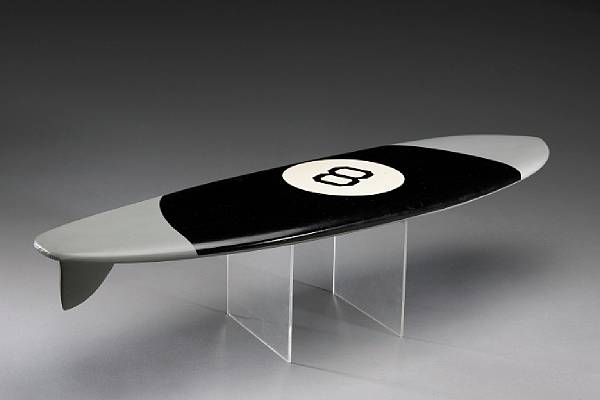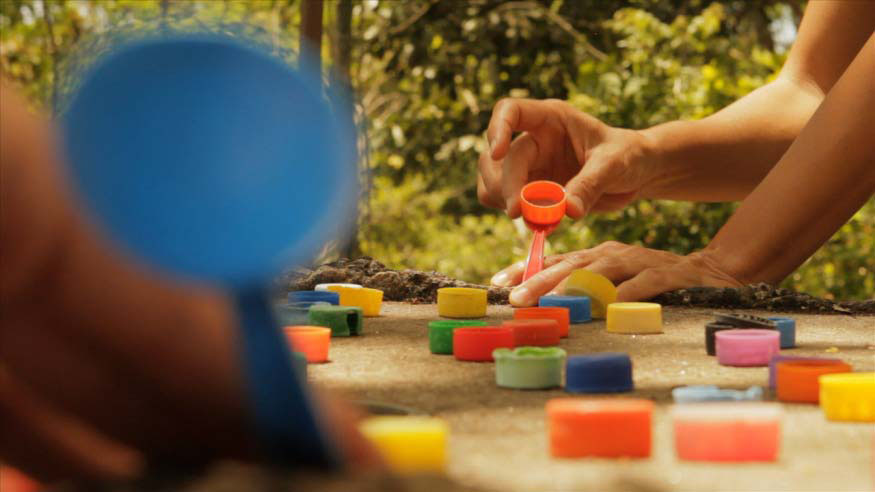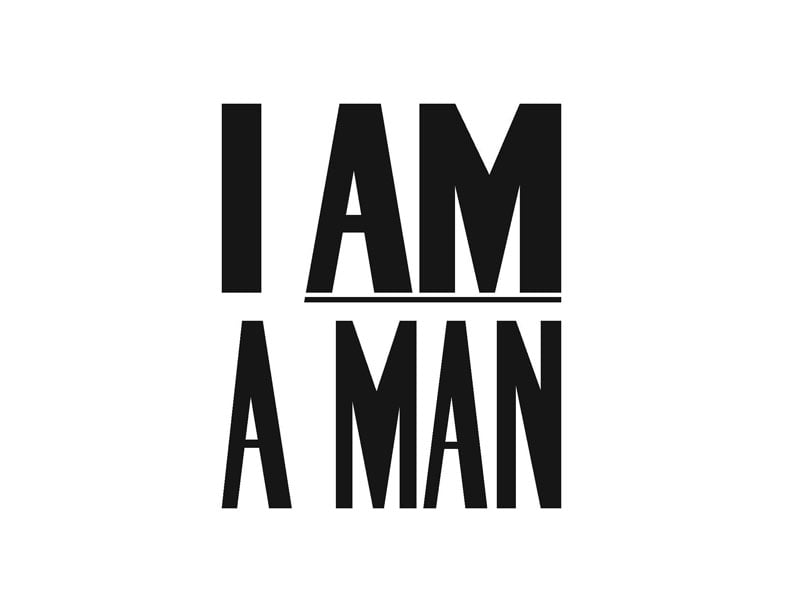
© » KADIST
Alexis Smith
In 8 Ball Surfboard (1995),Alexis Smith combines her long-term interests in California culture and conceptual assemblage. The surfboard, an emblem of Southern California, emblazoned with the image of an eight-ball, references numerous tropes and clichés of American popular culture, specifically subcultures related to pool halls, surfing, and beaches. Indeed, this model-scale surfboard may be a future pop-culture relic, referencing a particular surfer or era of board design.

© » KADIST
Donna Conlon and Jonathan Harker
In Tapitapultas (2012), Donna Conlon and Jonathan Harker comment on mass consumerism and pollution by way of a game they invented. The artists used disposable spoons as catapults to shoot thousands of plastic bottle caps at a hole in a concrete platform. The platform was once part of a U. S. military installation in the Panama Canal Zone, and it is now an observation deck in a nature park.

© » KADIST
Clare Rojas
Rojas’s two pieces in the Kadist Collection— Untitled (four-legged…) and Untitled (Bird’s Eyes) —are representative of her pictorial style which uses bold colorful blocks of paint and female and animal characters. While Untitled (Bird’s Eyes) does not depict any actual women, it nevertheless alludes to gender roles and the power of the female gaze. Apparently playful, this scene of two animals has an ominous quality: A bird and a hedgehog confront at each other and the bird appears to be poking, even eating the hedgehog’s eye.

© » KADIST
Alexis Smith
Iron Sorrows (1990) brings together what are for Alexis Smith common motifs and materials such as scavenged and repurposed metal, and street signage. Iron is one of nature’s most abundant metals. Smith, a philosopher of human detritus and poetic associations, presents it in this work as simultaneously everywhere yet paradoxically forgotten, lost in the heaps of refuse that fill junkyards and vacant lots.

© » KADIST
Clare Rojas
Rojas’s two pieces in the Kadist Collection— Untitled (four-legged…) and Untitled (Bird’s Eyes) —are representative of her pictorial style which uses bold colorful blocks of paint and female and animal characters. While Untitled (Bird’s Eyes) does not depict any actual women, it nevertheless alludes to gender roles and the power of the female gaze. Apparently playful, this scene of two animals has an ominous quality: A bird and a hedgehog confront at each other and the bird appears to be poking, even eating the hedgehog’s eye.

© » KADIST
Hank Willis Thomas
Drawing & Print (Drawing & Print)
Intentionally Left Blanc alludes to the technical process of its own (non)production; a procedure known as retro-reflective screen printing in which the image is only fully brought to life through its exposure to flash lighting. Using a found photograph depicting a passionate crowd of African Americans—their attitude suggesting the fervor of a civil-rights era audience— Intentionally Left Blanc reverts in its exposed, “positive” format to an image in which select faces are whitened out and erased, the exact inverse of the same view in its “negative” condition. This dialectic of light and dark re-emerges when we view the same faces again, only this time black and featureless, a scattering of disembodied heads amidst a sea of white.

© » KADIST
Hank Willis Thomas
South Africa Righteous Space by Hank Willis Thomas is concerned with history and identity, with the way race and ‘blackness’ has not only been informed but deliberately shaped and constructed by various forces – first through colonialism and slavery, and more recently through mass media and advertising – and reminds us of the financial and economic stakes that have always been involved in representations of race.

© » KADIST
Hank Willis Thomas
Drawing & Print (Drawing & Print)
Shot in black and white and printed on a glittery carborundum surface, Black Hands, White Cotton both confronts and abstracts the subject of its title. As with many of his works, the artist has taken a found image and manipulated it to draw out and dramatize the formal contrast between the black hands holding white cotton. Cotton, of course is one of the most familiar fabric sources to us, and becomes incredibly soft once processed.

© » KADIST
Hank Willis Thomas
The image is borrowed from protests during Civil Rights where African Americans in the south would carry signs with the same message to assert their rights against segregation and racism. Historically, in countries such as the US and South Africa, the term “boy” was used as a pejorative and racist insult towards men of color, slaves in particular, signifying their alleged subservient status as being less than men. In response, Am I Not A Man And A Brother?

© » KADIST
Hank Willis Thomas
Bread and Roses takes its name from a phrase famously used on picket signs and immortalized by the poet James Oppenheim in 1911. “Bread for all, and Roses, too’—a slogan of the women in the West,” is Oppenheim’s opening line, alluding to the workers’ goal for wages and conditions that would allow them to do more than simply survive. Thomas’ painting includes several black, white, brown, yellow, and red raised fists—clenched and high in the air in the internationally recognized symbol of solidarity, resistance, and unity.

© » KADIST
Hank Willis Thomas
Drawing & Print (Drawing & Print)
Thomas’ lenticular text-based works require viewers to shift positions as they view them in order to fully absorb their content. Meaning, therefore, changes depending on one’s perspective—and in the case of Thomas’ installation, only emerges when one knows that there is always something hidden, always more to one of his works than immediately meets the eye. This lenticular print with text shifts as you walk in front of it from its title, “Black Imitates White” to the inverse, “White Imitates Black”(and some other possibilities in between) emphasizing that there are always at least two perspectives to the same scenario, and thereby encouraging us as viewers to consider them all together rather than trying to identify with any one subjectivity.

© » KADIST
Hank Willis Thomas
Like many of his other sculptural works, the source of I am the Greatest is actually a historical photograph of an identical button pin from the 1960s. I am the Greatest presents the famous quote by Mohammad Ali to think about his important presence in the African American community. In dialogue with the painting I am a Man, also in the Kadist collection, this assertion that begins the same way takes the line from the protest poster several steps further.
Hank Willis Thomas
- location: New York, New York
- year born: 1976
- gender: male
- nationality: American
- home town: Plainfield, New Jersey
Clare Rojas
- location: San Francisco, California
- year born: 1976
- gender: female
- nationality: American
- home town: Columbus, Ohio
Alexis Smith
- location: Los Angeles, California
- year born: 1949
- gender: female
- nationality: American
- home town: Los Angeles, California
Donna Conlon and Jonathan Harker
- location: Panama City, Panama
- year born: 1966
- nationality: American and Ecuadorian
-
1990-1999
Alexis Smith
1990Iron Sorrows (1990) brings together what are for Alexis Smith common motifs and materials such as scavenged and repurposed metal, and street signage...
Alexis Smith
1995In 8 Ball Surfboard (1995),Alexis Smith combines her long-term interests in California culture and conceptual assemblage...
-
2000-2009
Clare Rojas
2006Rojas’s two pieces in the Kadist Collection— Untitled (four-legged…) and Untitled (Bird’s Eyes) —are representative of her pictorial style which uses bold colorful blocks of paint and female and animal characters...
Clare Rojas
2008Rojas’s two pieces in the Kadist Collection— Untitled (four-legged…) and Untitled (Bird’s Eyes) —are representative of her pictorial style which uses bold colorful blocks of paint and female and animal characters...
-
2010-2019
Donna Conlon and Jonathan Harker
2012In Tapitapultas (2012), Donna Conlon and Jonathan Harker comment on mass consumerism and pollution by way of a game they invented...
Hank Willis Thomas
Drawing & Print
2012(Drawing & Print) Intentionally Left Blanc alludes to the technical process of its own (non)production; a procedure known as retro-reflective screen printing in which the image is only fully brought to life through its exposure to flash lighting...
Hank Willis Thomas
2012Bread and Roses takes its name from a phrase famously used on picket signs and immortalized by the poet James Oppenheim in 1911...
Hank Willis Thomas
Drawing & Print
2012(Drawing & Print) Thomas’ lenticular text-based works require viewers to shift positions as they view them in order to fully absorb their content...
Hank Willis Thomas
2012Like many of his other sculptural works, the source of I am the Greatest is actually a historical photograph of an identical button pin from the 1960s...
Hank Willis Thomas
2013The image is borrowed from protests during Civil Rights where African Americans in the south would carry signs with the same message to assert their rights against segregation and racism...
Hank Willis Thomas
2014South Africa Righteous Space by Hank Willis Thomas is concerned with history and identity, with the way race and ‘blackness’ has not only been informed but deliberately shaped and constructed by various forces – first through colonialism and slavery, and more recently through mass media and advertising – and reminds us of the financial and economic stakes that have always been involved in representations of race....
Hank Willis Thomas
Drawing & Print
2014(Drawing & Print) Shot in black and white and printed on a glittery carborundum surface, Black Hands, White Cotton both confronts and abstracts the subject of its title...
